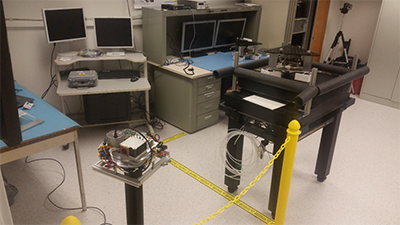
The Guidance and Control Spacecraft Autonomy Testbed (GSAT) is used for developing autonomous guidance, navigation and control (GNC) algorithms, relative sensor technologies, and science and engineering payloads that require GNC functionality to perform correctly. Its unique capabilities allow high fidelity, system-level ground testing of spacecraft architectures and autonomous operations. A key advantage of the GSAT is that it allows investigations into the true dynamics of a spacecraft under either active or passive control and the interaction with sampling/landing surfaces or docking with other bodies in space.
The GSAT, located in what is colloquially known as the “Robodome,” is a technology development testbed for a variety of research areas and future mission concepts including:
- Precision formation flight (distributed telescopes, Earth science)
- Proximity operations and descent through landing (small bodies and moons)
- Autonomous rendezvous and docking (sample capture, debris capture)
- Vision-based and relative sensor development
- Small satellite characterization and motion studies
- Robotic manipulation, interaction and reactive dynamics

The GSAT has a variety of hardware test platforms. The largest platforms are a pair of air-bearing-supported robots, each with full, independent 5.5 degree-of-freedom motion. It allows testing with flight-like hardware on a platform featuring 16 thrusters for translation and attitude control, along with reaction wheels, onboard inertial measurement sensors, processing capabilities, wireless communications, controlled lighting conditions for vision-based navigation, and external truth sensing of motion.
Additionally, a set of smaller, planar air bearings are used for testing SmallSat and CubeSat components and algorithms. Two air bearings float to allow a test payload to control the system, while another pair of air bearings have thrusters for translational and rotational control akin to the larger air bearings. The facility also maintains a spherical air bearing for attitude control and estimation for smaller systems. A hardware library provides independently-tested components to projects, and these components may be incorporated onto any of the planar or spherical air bearings. These components have been tested and characterized in JPL facilities, and models of these components are included in a highly modular and adaptable 6DOF simulation that supports analytical system dynamics modeling at varying levels of fidelity and software/hardware maturity. With these tools, the GSAT can be used by technologists, flight projects, and proposal teams to mature, characterize, or quickly assess their system performance. By bringing a measure of maturity and fidelity to spacecraft verification and validation efforts, TRL-raising activities, and more complex mission-level concepts such as formation flying or autonomous rendezvous and docking, the GSAT enables JPL to develop and test mission concepts suitable for science and interplanetary missions.

Related publications:
- Shields, J., Pong, C., et al., “Characterization of CubeSat Reaction Wheel Assemblies", Journal of Space, 2017.
- Sternberg, D., Pong, C., et al., "JPL Small Satellite Dynamics Testbed Simulation: Validated Models for Predicting On-Orbit Performance", Journal of Spacecraft and Rockets, Vol. 55, No. 2, pg. 322-334, 2018.
- Lai, P., Sternberg, et al., "Lunar Flashlight CubeSat GNC System Development for Lunar Exploration", International Astronautical Congress, IAC-18.B4.8.4, Bremen, Germany, 2018.
- Smith, M., Fesq, L., et al., “The ASTERIA Extended Mission: Results from the Past Year”, Small Satellite Conference, UT, 2019.
- Fesq, L., Beauchamp, L., et al., “Extended Mission Technology Demonstration using the ASTERIA Spacecraft”, IEEE Aerospace Conference, Big Sky, MT, 2019.
- Lai, P., Sternberg, D., et al., "Lunar Flashlight CubeSat GNC system development", Acta Astronautica, Vol. 173, pg. 425-441, 2020.
- Jia-Richards, Lozano, P., et al., "Feasibility of a Deep-Space CubeSat Mission with a Stage-Based Electrospray Propulsion System", IEEE Aerospace Conference, Big Sky, MT, 2020.
- Sternberg, D., Lai, P., et al., "Pre-Launch Testing of the Lunar Flashlight (LF) CubeSat GNC System", Journal of Small Satellites, Vol. 10, No. 1, pg. 959-981, 2021.
- Fesq, L., Beauchamp, L., et al., “Results from the ASTERIA CubeSat Extended Mission Experiments”, IEEE Aerospace Conference, Big Sky, MT, 2021.
- Wapman, J., Sternberg, D., et al., “Jet Propulsion Laboratory Small Satellite Dynamics Testbed Planar Air-Bearing Propulsion System Characterization”, Journal of Spacecraft and Rockets, Vol. 58, No. 4, pg. 1-18, 2021.
- Delaune, J., Izraelevitz, J., et al., “Mid-Air Helicopter Delivery at Mars Using a Jetpack”, IEEE Aerospace Conference, Big Sky, MT, 2022.
- Sternberg, D., Lo, K., et al., “Night Sky Testing of the Lunar Flashlight Star Tracker”, IEEE Aerospace Conference, Big Sky, MT, 2022.
- Rivera, K., Sternberg, D., et al., “Multi-Platform Small Satellite Dynamics Testbed”, IEEE Aerospace Conference, Big Sky, MT, 2023.
- Moncton, M., Jia-Richards, O., et al., “High Specific-Impulse Electrospray Explorer Trajectory Guidance and Control Air Bearing Demonstration”, Journal of Spacecraft and Rockets, Articles and Advance, pg. 1-10, 2024. https://doi.org/10.2514/1.A35931
- BiBlade sampling tool validation for comet surface environments - https://ieeexplore.ieee.org/document/7943760
- Scaling controllable adhesives to grapple floating objects in space - https://ieeexplore.ieee.org/document/7139584